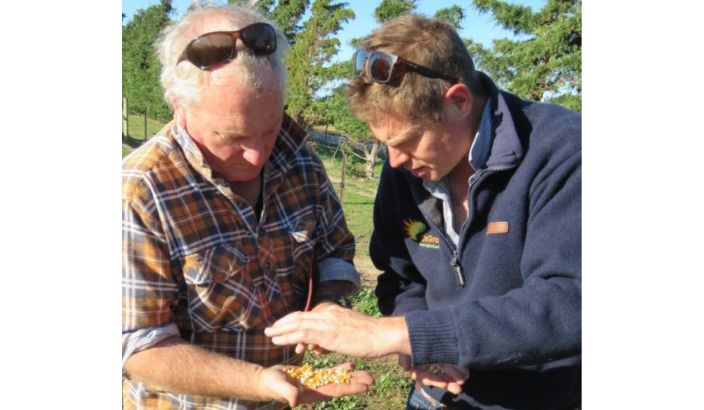Popcorn may be 8000 years old


Alan Jones from Garlico and Jeremy Oswald from Osgro Seeds inspect a popcorn sample for signs of harvester damage. Photo: Andrew Ritchie.
Andrew Ritchie
During the last balmy days of autumn, a centuries old crop was being harvested on a Seaview property south of the Seddon township.
Alan Jones of Garlico was combining 20 hectares of popcorn. The crop was coming off at an ideal moisture content of 26% at a rate of 7 tonnes/ha. The popcorn will be dried down to 13/14% moisture before use. The corn, resembling the maize or sweetcorn plant was precision sown in November. The axial flow harvester is ideal for gently separating the bright amber seed from the cob without cracking which would prevent the corn from popping.
Scientists believe popcorn originated in Mexico some 8000 years ago. By the time Columbus discovered the Americas over 700 types of popcorn were being grown.
By 1890 glass sided popcorn machines were popular attractions at fairs and festivals and by 1925 popcorn was being sold inside picture theatres where the cooking smells would no doubt stimulate sales. During the depression years of the 1930s vendors sold popcorn in 5 cent bags and it became one of the few affordable luxuries of the time. Inside the theatre it was now sold in paper buckets as rustling bags made too much noise.
Popcorn differs from other types of corn because its hull is just the right thickness to allow it to burst open. Each kernel of corn contains a small drop of water stored inside a circle of soft starch. As it heats to 200 + degrees the water turns to steam and the starch into a gelatinous substance. The pressure inside the grain will reach 135 pounds per square inch before the hull bursts open.
The nutritional value of popcorn is 78% carbohydrate,12% protein and 4% fat plus additional dietary minerals and vitamins. Excluding any salt or additives you might choose to include during the cooking process.
